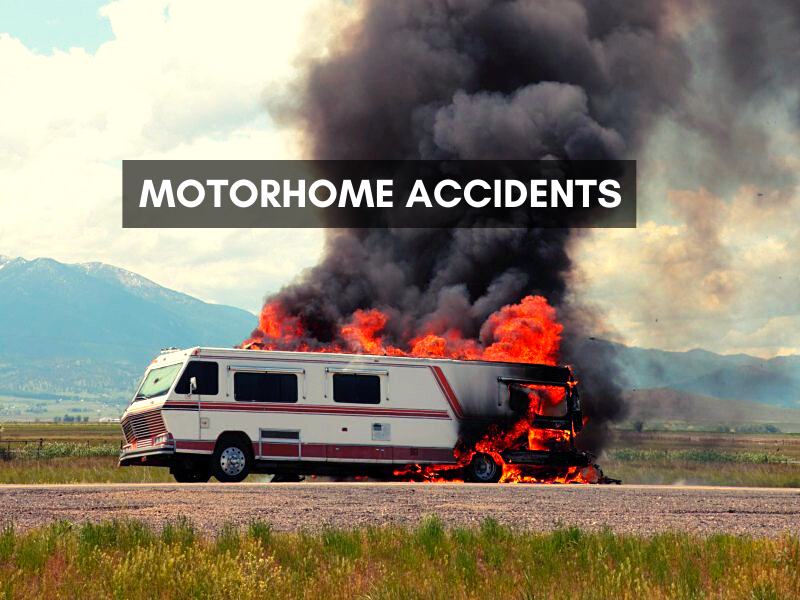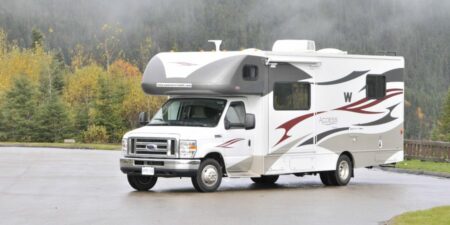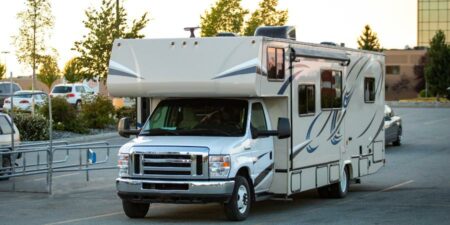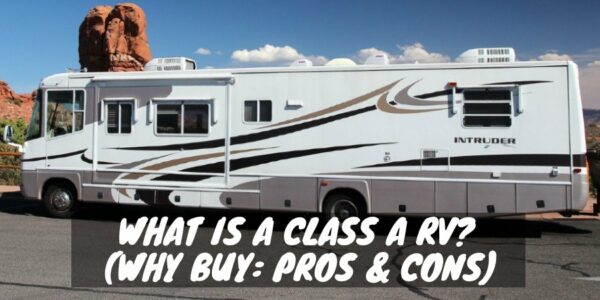RV travel season is heating up, so you’ll be spotting more motorhomes on the road. Driving such a large and heavy vehicle can be challenging, so taking precautions to arrive at your destination safely is crucial.
The problem is, no matter how cautious you try to be, motorhome accidents can happen in the blink of an eye. To help you visualize what accidents I’m talking about, I put together some scary motorhome accidents caught on video and explain ways to avoid such mishaps happening to you.
Some of these videos are very alarming, but they are very real. So give them a look and learn from others’ mistakes so that you can have a fun and safe RV camping season in your Class A, Class C, or Class B motorhome!
7 Scary Motorhome Accidents Caught on Video
1. Motorhome Goes Airborne, Then Careens Off the Bridge
In this disturbing video below from Washington state, you can see a motorhome driver lose control, hit a concrete barrier, cross all lanes of traffic, crash through another barrier and guard rail, and hang precariously off the beginning of a bridge.
Motorhome Becomes Airborne, Launches off Bridge (Bremerton, WA) (Video)
Thankfully, the motorhome came to rest on the steep embankment, but the driver never regained consciousness. The story begins with the driver, who was 71, taking his RV in for a radiator repair. Authorities believe the driver then lost control due to a heart attack or similar event that rendered him unconscious.
This video clearly demonstrates how quickly large and heavy motorhomes can travel and how devastating the destruction can be for the driver, passengers, other vehicles, and private or personal property.
What You Can Learn from This Video
The biggest lesson to learn from this video footage is to ensure you have regular health checkups that can hopefully detect issues such as heart conditions that can render you incapable of controlling your RV while on the road.
Another tip is having an adult in the passenger seat who can try to quickly take control of the wheel and stop the motorhome in such an event.
Lastly, travel at slower speeds instead of being in a rush so you can be more aware of your surroundings. Play the “what if” game while driving to locate places up ahead you could pull off the road safely if you’re feeling faint or ill.
2. Motorhome Tires Gets Stuck Leaving Road on Sharp Turn
This video of a motorhome making too sharp of a turn shows you what accidents can await RV drivers who are overconfident of their skills.
RV Stuck on Tobes Creek (Video)
This driver has a long motorhome, which needs plenty of roadway to keep all tires on the pavement when making turns. Unfortunately, he cut the turn too sharply, and the tires rolled onto a soft shoulder. The massive weight of the motorhome quickly bogs the wheels down into the dirt and mud, leaving him stuck and damaging the motorhome’s side panels, wheels, and axle.
The leaning RV looks like it can tip over! The time and expense to get a heavy-duty tow truck out to free a motorhome from this type of accident will ruin anyone’s vacation plans.
You can see at the end that if he had just slowed down and pulled more forward before starting his turn, he could have cleared this sharp turn safely!
What You Can Learn from This Video
The first thing to learn from this video is to know your motorhome’s turning ratios, rear swing-out, and tire clearance well before starting a road trip of any length.
The best way to know how much space you need for making safe turns is for all motorhome drivers to practice in an empty parking lot. Remember that there’s also a swing-out of the motorhome rear, dependent on the location of the back axle. So it’s best if you learn what is happening behind you on turns to avoid smashing or scraping the rear of your RV into obstacles.
Set up cones, and have a partner outside taking measurements and giving you tips on what is safe and what’s cutting it too close for both wheel and swing-out clearance. Knowing how far you need to pull forward before starting your turn can mean the difference between keeping all your tires on the pavement or ending up with those inner wheels off the road.
Having a “feel” for maneuvering on turns is also helpful when pulling into gas stations or store parking lots, which will keep your RV from damage and keep other people and property safe.
Lastly, measure how much clearance you have between the bottom of your tires and the bottom edge of your motorhome so you know how much of a dip you can handle off the pavement without bottoming out and damaging your camper.
3. Motorhome Tire Blows Out on Highway
This horrific video footage from the Louisiana State Police shows how a tire blowout on a Class A motorhome can be devastating.
Breakdown of the RV Tire Blowout Video ~ How It Happened and How to Handle Blowouts (Video)
This motorhome towing a truck had the front driver’s side tire unexpectedly blow, causing the driver to lose control and veer sharply into the median. While they did a good job trying to keep the RV straight and upright, it soon turned and flipped onto its side.
There isn’t information on what happened after the accident or how the passengers fared, but it’s safe to assume the Class A motorhome was a total loss.
What You Can Learn from This Video
Luckily, the rest of the video goes on to explain why motorhome tires can blow out and what steps to take to lower the risk of it happening to you.
For a quick video recap, the first thing to remember is never to overload RV tires past their ratings. Unfortunately, many motorhome owners fail to take their camper for a weigh-in at a local truck stop or weigh station to see their actual numbers.
Modern scales can tell you how much weight is pressing upon each tire, making it easier to adjust if you’re near or over the limit. Remember that many RV owners overpack their camper and don’t know they have exceeded their GVWR.
Another reason RV tires blow is that the tire inflation isn’t up to the manufacturer’s suggested PSI. In addition, driving at highway speeds on an underinflated tire leads to more friction and heat buildup that can blow the tire.
Checking tire inflation before, during, and after RV trips is crucial to catch low-tire problems before they cause damage. Installing a tire-pressure monitoring system, or TPMS,
Many RV owners also try to stretch out the time between tire replacements because changing out 4-6 heavy-duty motorhome tires is expensive. Instead, look for signs of tire wear and tear before and during trips, and always replace tires once they reach their lifespan (typically 3-5 years), no matter how good they still “look.”
Lastly, watch this best way to handle an RV tire blowout video (below) by RVIA that can help you know what to expect and how to stop your camper with the least amount of damage safely. A hint is that slamming on the brakes when a tire blows is the LAST thing you want to do, so please watch the video to learn more.
How to Handle a Tire Blowout in Your RV (Video)
4. Motorhome Smashes Into Fuel Island
Pulling into gas stations in a motorhome is always a challenge, and this poor driver in this video shows what happens when you misjudge distances and turn too soon.
RV Hits Fuel Island (Video)
The rear of the motorcoach hits the barrier at the end of the fuel island and crushes and rips up the side panels and parts of the wheel, but luckily doesn’t directly hit the gas pumps. Nevertheless, the driver suffers extreme embarrassment and a hefty bill for a tow truck rescue and RV repairs at a dealership.
What You Can Learn from This Video
This motorhome accident is another one that the driver could have avoided if they were paying more attention to the turning clearance.
Unfortunately, there are many gas stations that you should never pull your motorhome into because there just isn’t enough room for you to maneuver safely.
A great tip is to plan your fuel stops at larger gas stations or travel centers that offer plenty of room to enter and exit. Then, if you’re on the road, search online for RV-friendly gas stations to avoid the ones that can get you in trouble.
5. Motorhome Gets Destroyed by Low Bridge
In this video below, an expensive Class A motorhome apparently didn’t see the low-clearance signs for this train bridge. At only 9′ 9″, very few motorhomes or travel trailers would fit, but this driver found out the hard way by having the entire top of his RV torn off.
RV Versus Low Train Bridge (Video)
The driver must have thought that since they made it unscathed under the first bridge, they would make it under the second, which is clearly much lower. Unfortunately, this RV will be a total loss, and its possible insurance may deny their accident claim as they ignored the warning signs.
What You Can Learn from This Video
To avoid this type of accident, you first must know your exact RV height, including any equipment on the roof, such as your air conditioner, vent covers, or satellite dish. Never trust the height from the RV brochure or the salesperson tells you at the dealership; climb up there and measure it yourself.
Once you know your RV height, always give yourself at least a six-inch buffer when trying to pass under low bridges or overpasses, as those signs may not be accurate either.
Another great tip is to invest in an RV-specific GPS or app that allows you to plug in your motorhome’s dimensions. The program will then only show you routes that are safe for your RV to travel and will keep you off backroads or city streets where low bridges are more common.
6. Motorhomes Catch Fire
In this first shocking video, a motorhome driver backed up over the power pedestal, causing a spark that ignited a fire that quickly turned into an inferno.
Motorhomes Catch Fire (Video)
Want to Connect With a Community of Over 1,078 RV Enthusiasts?
This second video shows another motorhome engulfed in flames, this time coming from the engine compartment, which could have overheated or shorted and caused this fire.
RV Fire (Video)
In this third video, you can see the damage an electrical fire causes in a motorhome when the Norcold refrigerator was faulty. At 6:30 in the video, the owner discusses what the fire inspector told him about other recent RV fridge fires he investigated.
RV Fire Caused by Fridge (Video)
What You Can Learn from This Video
The lesson to learn from the above videos is just how quickly your entire motorhome can go up in flames. In most instances, owners say it took under ten minutes for total destruction.
To help you avoid a fire in your RV, you first want to take extra care whenever parking your motorhome. Backing up with a camera system or a helper can easily lead to you smashing into power poles, water or sewer connections, trees, fences, or buildings.
Don’t neglect your motorhome engine. Take your RV in for regular tune-ups, and if you are running your motorhome for extended miles while on RV trips, take breaks every few hours to let your engine cool down.
As for electrical issues, it’s always wise to have an RV electrical professional give your motorhome a complete inspection once a year. An expert can test all the outlets and wires for proper voltage and catch issues before overloads, shorts, or fires occur.
Another safety tip is not to run your propane while driving to keep your fridge cold, as it can lead to a leak where any spark can cause a fire.
The last thing you can do to avoid an out-of-control RV fire is to install an RV fire suppression system, as shown in this video.
Proteng Automatic Fire Suppression and Detection Device (Video)
A fire protection system is a great way to ensure you have an extra layer of protection, especially when you’re away from your RV for the day or you’re sleeping at night.
7. Motorhome Flips Off Cliff in High Winds
This frightening video shows how easy it is for winds to push over a motorhome when traveling down the highway.
Camper Flips over Cliff (Video)
This small motorhome struggled under strong winds, which eventually pushed it off the roadway, over on its side, and down a cliff. Imagine how terrified the driver and passengers were at this moment!
Every RV owner can attest that trying to drive in high winds is very scary, and gusts from weather events or even a passing semi-truck can send your motorhome rocking or veering from the lane.
What You Can Learn from This Video
The lesson from this video is that wind will affect your motorhome a hundred times worse than it does an automobile. This is because motorhomes have wide, long, flat sides that act as a sail to catch the wind, which, if strong enough, can flip your RV over.
Before and during your RV trips, keep an eye on the weather from your phone, tablet, or radio so you can find a place to park if bad storms or high winds are in the forecast.
If you are stuck in high winds on the highway, don’t try to keep up with traffic. Instead, move to the right and slow down as much as you safely can until you can find a place to pull over. Park your motorhome so the front faces the wind head-on to minimize sway.
Final Thoughts
Motorhome accidents happen daily across the US, and many could be prevented if the owners were better aware of the dangers and how to avoid them.
I hope this article and shocking videos encourage you to learn more about how you can prepare yourself and your RV for safe road trips to avoid tire blowouts, fires, and crashes.
RV trips in a motorhome provide tons of fun and a lifetime of memories, so stay safe out there and enjoy every adventure!
"Man cannot discover new oceans unless he has the courage to lose sight of the shore."
-- Andre Gide










